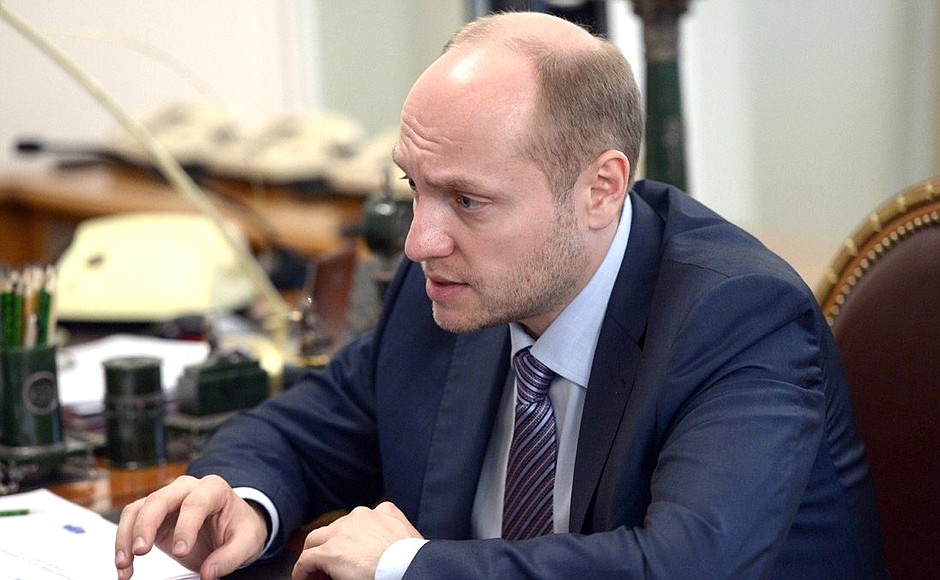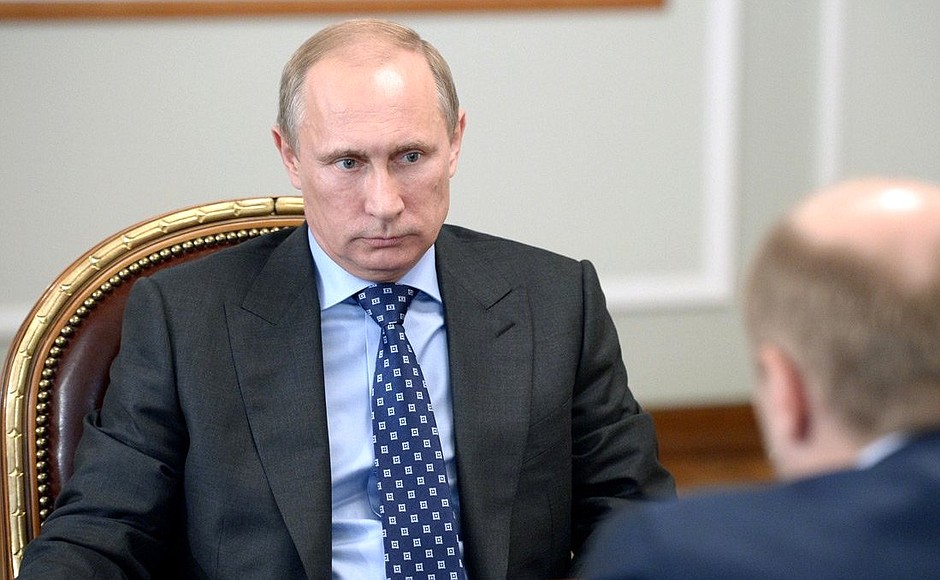President of Russia Vladimir Putin: Mr Galushka, how long have you been working?
Far East Development Mininster Alexander Galushka: Nine and a half months.
Vladimir Putin: Nine and a half months. It’s time to see some results.
Alexander Galushka: Mr President, our work began during the time of the floods. And, of course, the first months of our work were devoted to overcoming the aftermath of that disaster.
Currently, the Ministry has the situation entirely under control. We are essentially playing a coordinating role: the Ministry coordinates the work of various federal agencies, regions and municipalities. We are monitoring the situation, reacting quickly to citizens’ appeals and to the existing problems. Some difficulties have come up while dealing with the aftermath of the crisis. But overall, we are reaching a situation where the critical mass of the housing will be ready by September 1 of this year, and the rest – as the governors already reported to you – will be ready by September 30, as established by your Executive Order.
Vladimir Putin: There are currently problems in Magadan.
Alexander Galushka: Yes, we have problems in Magadan. But given the practice we have developed in the time since overcoming the crisis, we and the Emergency Situations Ministry are managing the situation in routine mode, although it is an emergency.
Overcoming the aftermath of the emergency is certainly a challenge; it is a special challenge. But since the first day of our work, we focussed on issues of developing the Far East.
For us, as a territorial ministry, it was very important not to allow what happens in certain sectoral departments, and not turn into a second transport ministry or healthcare ministry under any circumstances; but at the same time, we are really focusing on the key priorities that will truly allow for advanced, accelerated development in the Far East.
In your Address to the Federal Assembly, you defined the Far East as a national priority for the 21st century, giving instructions to work on the issue of creating a network of priority development areas. We have already reported to you that we performed a detailed analysis, are conducting marketing work, and have prepared a draft law.
The most important intended result of this work is that we must use these priority development areas to successfully win the competition with our direct competitors in the Asia-Pacific Region in creating investment conditions and doing business in the Far East.
Can this be done? It’s hard, but it’s possible. We can see that foreign investors understand and are responding to the work being done today by the Ministry; they are expressing genuine interest.
The most important issue for them is – they’re basically talking about one thing: “Just do what you are offering to do – adopt the draft law and the platforms you are showing us.” They say, “We are speaking the same language.”
This is a familiar instrument for them; South Korea and China offer similar opportunities. Japan has now begun doing the same thing; at the end of last year, Japan also adopted a new law on special strategic zones. We are carefully studying everything that our competitors are doing in this area to understand how we can do it better.
We expect that after the draft law is passed, after the necessary financing is issued (we have calculated everything for each priority development area – both the necessary investment and potential results that can be achieved), we can begin the project of creating priority development areas and attracting new investors starting on January 1, 2015. This is essentially a greenfield.
The key thing here I want to stress is that we reached an understanding with the Finance Ministry and the Government that if we create these favourable conditions, including providing a package of tax benefits, investors will come to us. If we do not do this, they simply will not come here; it will be our missed opportunity. That is the dilemma.
Of course, we are starting by planning the correct management of this process, planning to create supervisory councils for each priority development area, so that everything is transparent, clear and organised as effectively as possible.
As a result, what will these priority development areas give us? In the next 10 years, the first 14 priority development areas that have been selected today and are best suited for this will yield one trillion rubles [over $27 billion] in private investments, extra-budgetary investments that we can attract and that we would not be able to attract if we did not have such an instrument.
Here’s our second priority. We are meticulously analysing the investment projects that exist in the Far East, and partial implementation may have even begun for some of them. We have carefully and professionally studied over 340 investment projects in the last six months.
We selected the best-prepared and most effective projects out of 340 – ones that can have a significant effect in terms of developing the area. In total, we had 18 projects that satisfy the characteristics and requirements I talked about. In total, these projects will give the Far East 2.5 trillion rubles in private investments.
Each project has a specific, clear private investor; these are mainly Russian investors, unlike in the first case (priority development areas are ultimately more suited for foreign investors). In essence, I would say that implementing these projects essentially means creating a new economy in the Far East. The priority development zones combined with investment projects will result in doubling the Far East’s GRP in ten years.
Moreover, this is not just an abstract exercise. We have done the corresponding calculations with investors, and our colleagues in the Government have also looked into them thoroughly. We built a state programme around these projects, expressing all of this in the language of the government programming and forwarded it to the Government.
Here are some noteworthy examples. Two ore mining and processing enterprises have been launched in Chukotka since the start of the year, and the industrial production index in this region of Russia is at 183 percent. The new economy is being built on this kind of applied microeconomic design work.
Vladimir Putin: We just need all this to have practical results, as it did in Chukotka.
Alexander Galushka: Absolutely, Mr President.
Vladimir Putin: It mustn’t just remain on paper.
Alexander Galushka: I can say that for me, personally, this is the most important issue. To be honest, I am not used to doing such exercises. In general, what I want most is to achieve results.
The third priority is very important. Breakthrough zones such as priority development areas, as well as the implementation of investment projects that we support and follow individually, are vital; but the comprehensive development of Far East territories and the social sector are no less important.
In this regard, we at the Ministry have organised and conducted work to analyse a wide range of government smes from the point of view of how the Far East is represented in those programmes: the Far East’s share in the healthcare, education, and social support programmes. This work had not been conducted before.
What did we discover? On the one hand, we can see objectively that the territory of the Far East has not yet been developed.
Vladimir Putin: Of course.
Alexander Galushka: According to social sector characteristics, the living standards are behind the average indicators. Moreover, the state programmes in the Far East are underfunded per person (even though we have few people living there – only 6.2 million) compared to average national indicators.
We believe it’s a significant challenge to develop this territory, which is underdeveloped it is not represented in any way in the state programmes. There are examples in which funding per person was ten times lower than the Russian average.
We have done calculations that would level the field. If we simply bring the funding to the average national level, plus, perhaps, add a small priority development coefficient of 1.3, then that would be 400 million rubles of redistributed funding in state programmes in the next three years.
Vladimir Putin: In the Far East’s favour.
Alexander Galushka: Yes. Moreover, that is the rationale: let’s finance it normally, similar to the Russian average, or perhaps a little higher in certain areas. And then we will receive 400 billion.
This is also a resource for developing the territory. In this case, in our view, the Far East Development Ministry has a very clear niche: on the one hand, we are bringing the regions closer to Moscow, and on the other hand, Moscow becomes closer to the regions.
Why did this happen? When we began to look into it, it became clear that this is what’s called the “underdevelopment trap” in economics; it simply keeps getting put on the back burner. As for regional leaders, they also don’t want to fly to Moscow all the time to address every issue. And so this is what happens. We analysed this situation together with the regions.
We have solid suggestions for concrete facilities: they include hospitals, athletic facilities and social infrastructure. This resource is reinforced by specific proposals for facilities and measures that we developed with the Far East regions.
We have taken this problem to the Prime Minister, reporting it accordingly. We received instructions on what needs to be emphasised in the state programmes to receive priority financing.
For now, this work is ongoing – it’s not easy, but it is progressing. In our view, it would be enough to just do these three things: complete the 18 most promising investment projects, bringing them to their logical conclusion, to the product launch, job creation, taxes; designating priority development territories for attracting new investments that are aimed first and foremost towards Asia Pacific Region markets; and make changes in the state programmes, determining their priorities and ensuring sufficient financing for the Far East. All this, taken together, is a development resource for the Far East and its upsurge.
Vladimir Putin: That is realistic, I agree.
Alexander Galushka: This work is not easy; it’s a challenge, but it can be done.
<…>


